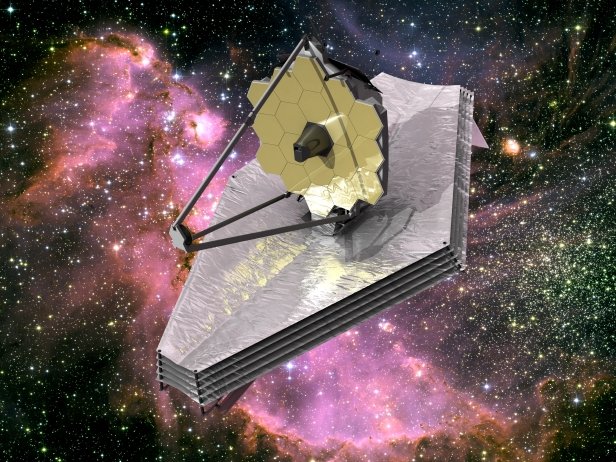Ten reasons why NASA’s James Webb Space Telescope will kick some cosmic butt:

- It’s as big as a tennis court
With a sunshield 22 metres (72 feet) in length, the size of a tennis court, and a mirror 6.5 metres (21 feet) wide the JWST, which is due to launch in October 2018, is over twice the size of the Hubble Space Telescope, making it the largest space telescope ever launched.
2 . The mirrors are coated in a golf ball’s worth of gold
The JWST’s mirrors are covered in gold to optimise them for infrared light, with the gold further protected by a thin layer of glass. The thickness of this gold coating is 0.00001 centimetres across the 25 square-metre mirror’s surface, and in total the gold weighs 48.25 grams, roughly equivalent to the weight of a golf ball.
3 . It’ll be about four times further from Earth than the Moon
The JWST will take about a month to reach a position 1.5 million kilometres (930,000 miles) from Earth known as Lagrange point 2, or L2. Here the telescope’s observations will be unhindered by Earth and the Moon although, if it malfunctions (as happened with Hubble), we currently have no way to go and fix it.
4 . It could see a penny 24 miles away
The angular resolution of the JWST, which is the sharpness of the images, is incredibly precise. It can see at a resolution of 0.1 arc-seconds, which means that it could resolve a penny 24 miles (40 kilometres) away or a football 340 miles (550 kilometres) away.
5 . It could find water on exoplanets
One of the JWST’s most notable abilities is that it will be able to detect planets around nearby stars by measuring infrared radiation, and it will even be able to measure the atmospheres of exoplanets by studying the starlight that passes through. By doing this it will be able to determine if an exoplanet has liquid water on its surface.
6 It’s seven times more powerful than the Hubble Space Telescope
The giant mirror of the JWST is made of 18 individual hexagonal segments composed of lightweight beryllium. It is almost three times the size of Hubble’s mirror, boasting a light-collecting area seven times greater, but both mirrors weigh almost the same owing to the lighter materials used on the JWST’s mirror.
7 . It’ll see the first light of the universe
One of the goals of the JWST is to observe the first stars and galaxies that formed just a few hundred million years after the Big Bang, an era of the universe that is not fully understood. The telescope will be sensitive to infrared light, which will enable it to do this.
8 . It will unfold to its massive size in space
Many features of the JWST, including its giant mirrors and sunshield, are designed to be launched on a rocket in a smaller payload. The telescope will launch in a compact outfit and will unfold in its full configuration once it reaches space.
9 . One side is hotter than Death Valley, the other is colder than Antarctica
The side of the JWST that will always face the Sun, the bottom of the sunshield, will reach temperatures of 85°C (185 °F). The other side, which houses the mirrors and science instruments, will operate at a much nippier -233°C (-388 °F).
10 . It could keep working for a decade
The official mission lifespan for the JWST is between five and ten years. The telescope is limited by the amount of fuel it has on board used to maintain its position, which will be enough for a ten-year lifetime. Of course, other factors like budget cuts or malfunctions could end the mission earlier.
Hi! I am a robot. I just upvoted you! I found similar content that readers might be interested in:
https://www.spaceanswers.com/astronomy/ten-reasons-why-nasas-james-webb-space-telescope-will-kick-some-cosmic-butt/
Hi, I found some acronyms/abbreviations in this post. This is how they expand: